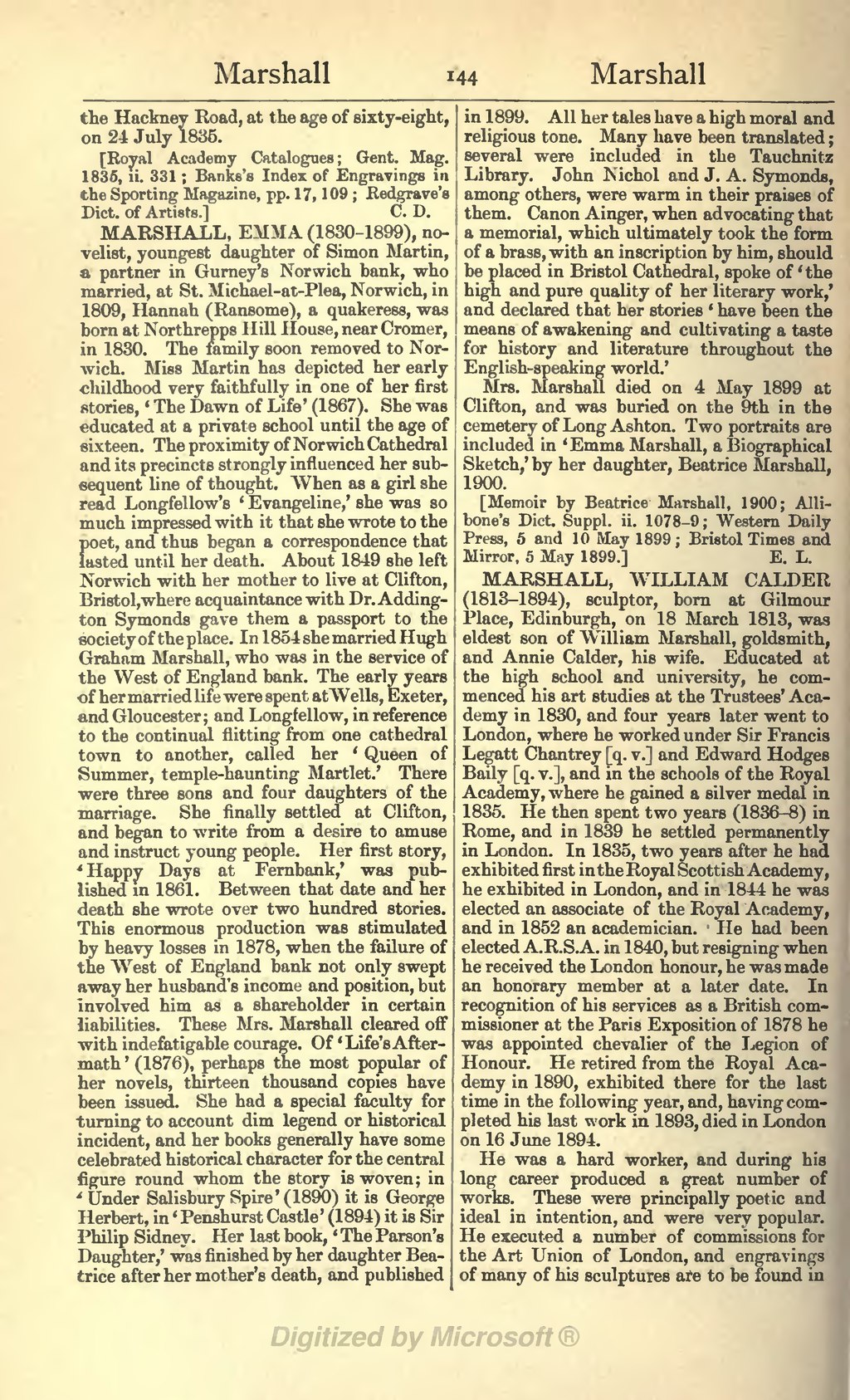the Hackney Road, at the age of sixty-eight, on 24 July 1835.
[Royal Academy Catalogues; Gent. Mag. 1835, ii. 331; Banks's Index of Engravings in the Sporting Magazine, pp. 17, 109; Redgrave's Dict. of Artists.]
MARSHALL, EMMA (1830–1899), novelist, youngest daughter of Simon Martin, a partner in Gurney's Norwich bank, who married, at St. Michael-at-Plea, Norwich, in 1809, Hannah (Ransome), a quakeress, was born at Northrepps Hill House, near Cromer, in 1830. The family soon removed to Norwich. Miss Martin has depicted her early childhood very faithfully in one of her first stories, 'The Dawn of Life' (1867). She was educated at a private school until the age of sixteen. The proximity of Norwich Cathedral and its precincts strongly influenced her subsequent line of thought. When as a girl she read Longfellow's 'Evangeline,' she was so much impressed with it that she wrote to the poet, and thus began a correspondence that lasted until her death. About 1849 she left Norwich with her mother to live at Clifton, Bristol, where acquaintance with Dr. Addington Symonds gave them a passport to the society of the place. In 1854 she married Hugh Graham Marshall, who was in the service of the West of England bank. The early years of her married life were spent at Wells, Exeter, and Gloucester; and Longfellow, in reference to the continual flitting from one cathedral town to another, called her 'Queen of Summer, temple-haunting Martlet.' There were three sons and four daughters of the marriage. She finally settled at Clifton, and began to write from a desire to amuse and instruct young people. Her first story, 'Happy Days at Fernbank,' was published in 1861. Between that date and her death she wrote over two hundred stories. This enormous production was stimulated by heavy losses in 1878, when the failure of the West of England bank not only swept away her husband's income and position, but involved him as a shareholder in certain liabilities. These Mrs. Marshall cleared off with indefatigable courage. Of 'Life's Aftermath' (1876), perhaps the most popular of her novels, thirteen thousand copies have been issued. She had a special faculty for turning to account dim legend or historical incident, and her books generally have some celebrated historical character for the central figure round whom the story is woven; in 'Under Salisbury Spire' (1890) it is George Herbert, in 'Penshurst Castle' (1894) it is Sir Philip Sidney. Her last book, 'The Parson's Daughter,' was finished by her daughter Beatrice after her mother's death, and published in 1899. All her tales have a high moral and religious tone. Many have been translated; several were included in the Tauchnitz Library. John Nichol and J. A. Symonds, among others, were warm in their praises of them. Canon Ainger, when advocating that a memorial, which ultimately took the form of a brass, with an inscription by him, should be placed in Bristol Cathedral, spoke of 'the high and pure quality of her literary work,' and declared that her stories 'have been the means of awakening and cultivating a taste for history and literature throughout the English-speaking world.'
Mrs. Marshall died on 4 May 1899 at Clifton, and was buried on the 9th in the cemetery of Long Ashton. Two portraits are included in 'Emma Marshall, a Biographical Sketch,' by her daughter, Beatrice Marshall, 1900.
[Memoir by Beatrice Marshall, 1900; Allibone's Dict. Suppl. ii. 1078-9; Western Daily Press, 5 and 10 May 1899; Bristol Times and Mirror, 5 May 1899.]
MARSHALL, WILLIAM CALDER (1813–1894), sculptor, born at Gilmour Place, Edinburgh, on 18 March 1813, was eldest son of William Marshall, goldsmith, and Annie Calder, his wife. Educated at the high school and university, he commenced his art studies at the Trustees' Academy in 1830, and four years later went to London, where he worked under Sir Francis Legatt Chantrey [q. v.] and Edward Hodges Baily [q. v.], and in the schools of the Royal Academy, where he gained a silver medal in 1835. He then spent two years (1836-8) in Rome, and in 1839 he settled permanently in London. In 1835, two years after he had exhibited first in the Royal Scottish Academy, he exhibited in London, and in 1844 he was elected an associate of the Royal Academy, and in 1852 an academician. He had been elected A.R.S.A. in 1840, but resigning when he received the London honour, he was made an honorary member at a later date. In recognition of his services as a British commissioner at the Paris Exposition of 1878 he was appointed chevalier of the Legion of Honour. He retired from the Royal Academy in 1890, exhibited there for the last time in the following year, and, having completed his last work in 1893, died in London on 16 June 1894.
He was a hard worker, and during his long career produced a great number of works. These were principally poetic and ideal in intention, and were very popular. He executed a number of commissions for the Art Union of London, and engravings of many of his sculptures are to be found in
